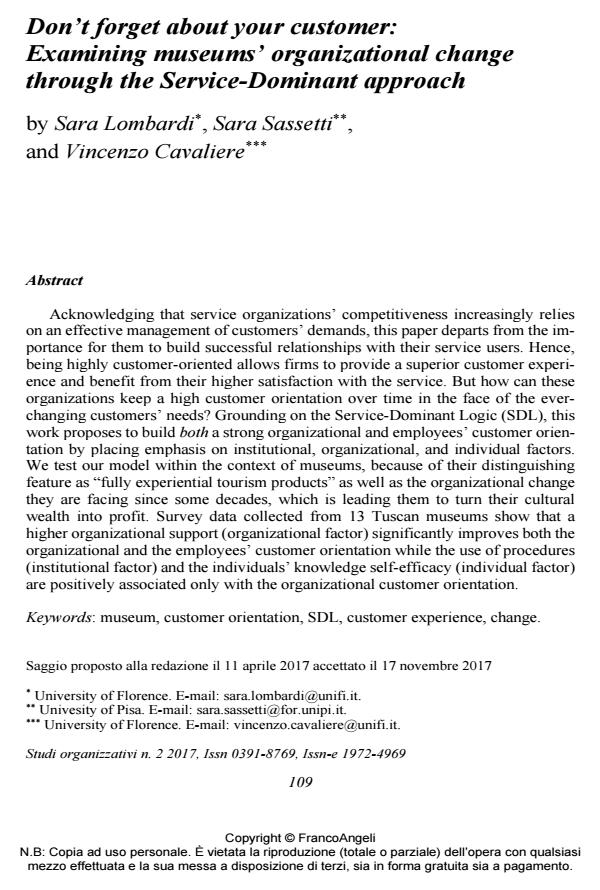Don’t forget about your customer: Examining museums’ organizational change through the Service-Dominant approach
Titolo Rivista STUDI ORGANIZZATIVI
Autori/Curatori Sara Lombardi, Sara Sassetti, Vincenzo Cavaliere
Anno di pubblicazione 2018 Fascicolo 2017/2
Lingua Inglese Numero pagine 25 P. 109-133 Dimensione file 257 KB
DOI 10.3280/SO2017-002006
Il DOI è il codice a barre della proprietà intellettuale: per saperne di più
clicca qui
Qui sotto puoi vedere in anteprima la prima pagina di questo articolo.
Se questo articolo ti interessa, lo puoi acquistare (e scaricare in formato pdf) seguendo le facili indicazioni per acquistare il download credit. Acquista Download Credits per scaricare questo Articolo in formato PDF

FrancoAngeli è membro della Publishers International Linking Association, Inc (PILA)associazione indipendente e non profit per facilitare (attraverso i servizi tecnologici implementati da CrossRef.org) l’accesso degli studiosi ai contenuti digitali nelle pubblicazioni professionali e scientifiche
Acknowledging that service organizations’ competitiveness increasingly relies on an effective management of customers’ demands, this paper departs from the importance for them to build successful relationships with their service users. Hence, being highly customer-oriented allows firms to provide a superior customer experience and benefit from their higher satisfaction with the service. But how can these organizations keep a high customer orientation over time in the face of the ever-changing customers’ needs? Grounding on the Service-Dominant Logic (SDL), this work proposes to build both a strong organizational and employees’ customer orientation by placing emphasis on institutional, organizational, and individual factors. We test our model within the context of museums, because of their distinguishing feature as "fully experiential tourism products" as well as the organizational change they are facing since some decades, which is leading them to turn their cultural wealth into profit. Survey data collected from 13 Tuscan museums show that a higher organizational support (organizational factor) significantly improves both the organizational and the employees’ customer orientation while the use of procedures (institutional factor) and the individuals’ knowledge self-efficacy (individual factor) are positively associated only with the organizational customer orientation.
A partire dagli ultimi due decenni, i musei sono stati interessati da un importante cambiamento, tanto istituzionale quanto organizzativo. Tale cambiamento ha imposto loro di valorizzare il patrimonio culturale in loro possesso traducendolo in profitto. Parallelamente, i musei hanno iniziato a subire un’ulteriore trasformazione: una trasformazione concernente la loro funzione di istituzione culturale. Da tradizionali spazi dediti alla conservazione di beni culturali a luoghi di apprendimento. Un apprendimento in cui ad assumere un ruolo centrale non è più solamente la cultura in sé, l’oggetto storico, l’artefatto. Ad emergere è piuttosto il visitatore, il turista, il cliente, la cui relazione col museo è elevata a fattore centrale su cui fare leva per superare il cambiamento. Il presente articolo trae origine da questa nuova concettualizzazione del museo, concentrando la propria attenzione sulla necessità di offrire un’esperienza che riesca a stimolare una reazione emotiva nel visitatore. All’interno dell’esperienza turistica, le emozioni tendono infatti a derivare da episodi di sensazioni intense scaturite non solo dall’oggetto tangibile che ha motivato la visita al museo, bensì molto spesso tali dal rapporto che si instaura tra il visitatore e il personale del museo che eroga il servizio, contribuendo alla costruzione di un’esperienza quanto più piacevole possibile. Ecco che le risorse umane del museo svolgono dunque un ruolo cruciale nel supportare il museo nella fase di transizione dal suo ruolo storico di mera istituzione culturale a luogo in cui a farla da padrone sono le emozioni, l’intrattenimento e la attiva costruzione, da parte del visitatore, di una conoscenza e un’esperienza maggiormente coinvolgenti rispetto a quanto succedeva in passato. Coerentemente con questa premessa, lo studio intende esaminare l’esperienza del museo come conseguenza di due principali aspetti: da un lato, l’orientamento del museo verso il visitatore, dall’altro, l’atteggiamento di cortesia adottato dal suo personale. Al fine di catturare la complessità del fenomeno oggetto di studio, gli autori analizzano questi due aspetti guardando all’impatto che variabili di natura organizzativa, culturale e individuale possono avere su di essi. L’analisi di dati raccolti attraverso una survey sottoposta al personale di 13 musei della Toscana dimostra che un più elevato supporto organizzativo (fattore culturale) è tale da rafforzare sia l’orientamento del museo nei confronti dei visitatori sia la tendenza del personale ad adottare un approccio cortese nell’erogare il servizio. Diversamente, l’utilizzo di regole e procedure (fattore organizzativo) e la knowledge self-efficacy delle risorse umane del museo (fattore individuale) manifestano una relazione positiva solamente nei confronti dell’orientamento al visitatore del museo.
Parole chiave:Museo, orientamento al cliente, cortesia, struttura, cultura, cambiamento.
Sara Lombardi, Sara Sassetti, Vincenzo Cavaliere, Don’t forget about your customer: Examining museums’ organizational change through the Service-Dominant approach in "STUDI ORGANIZZATIVI " 2/2017, pp 109-133, DOI: 10.3280/SO2017-002006